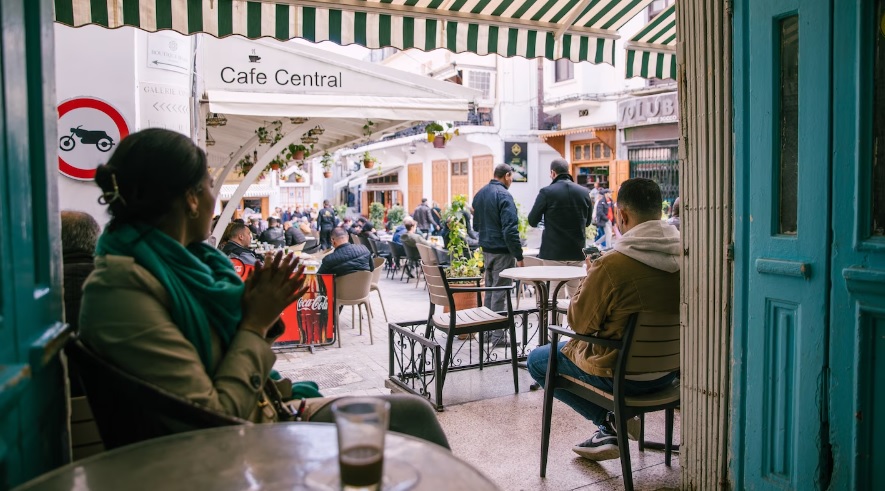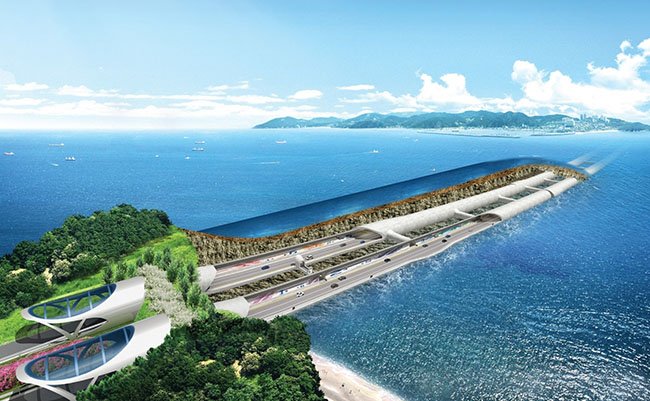To be in Tangier is to be well-caffeinated. There are so many places to sit, to read, to chat. I do not normally turn down a coffee invitation, but I would never think of doing so in Tangier.
Cafes play an outsize role in modern Moroccan society. One city block can have four or five; even a small town will have a few. It’s not uncommon to see someone sit down with a friend, stay for an hour or more, and order nothing at all.
Within Morocco, no other city can quite match Tangier’s historic cafe culture. In the 1950s and ’60s, expat writers and artists such as Paul Bowles and William Burroughs gave the city’s cafes their global renown. But many of the places that crowd frequented were already decades old when they arrived, and Moroccan luminaries like Mohammed Mrabet, Mohamed Choukri, and Mohamed Hamri were regulars on the scene, too. Plenty of their haunts are still around.
Alongside these institutions, a wave of creative Tanjawis have launched new, vibrant and more inclusive spaces to sit and sip. Cafes are mostly frequented by men, although Morocco’s run to the World Cup semifinals in December brought in women in unprecedented numbers. A new generation of cafe owners have made a point to appeal to more women.
So much attention still focuses on the American and European expat literati that gave the place its slightly seedy, counterculture reputation. Yes, the artistic expat community has been important to the city’s history and helped create the mystique of several cafes. But Cafe Hafa isn’t great because Mick and Keith smoked kif there 60 years ago. It’s great because you can sip tea and slurp bissara — a hearty soup of pureed split peas — from a hillside perch above the blue Atlantic, staring across the water at Spain.
Spanish writer Juan Goytisolo called Tangier a “wide open city in all senses of the word,” and this helped shape the city’s drinking habits today. Its coffee culture shows off its close connections to Europe.
The standard is espresso in a short glass. For something closer to an americano, go for an “allongé.” For something milkier than a cafe au lait, order a “nuss-nuss” (Arabic for “half-half”). You can even find some real Spanish torrefacto if you’re in the mood for something akin to burned acid.
Moroccan mint tea, or atay, is everywhere, although, as with so many things, Tangier puts a unique spin on the national drink. Spain colonized northern Morocco from 1912 to 1956, and during World War II, they struggled to maintain supplies of basic staples. Tea was one such staple, so local cafes adapted by serving glasses stuffed to the brim with mint to stretch out their meager rations. In southern cities, cafes typically serve small pots of strong tea with little glasses for you to self-serve. In the north, the standard is still a tall, heavy glass filled with a lighter, amber liquid and verdant leaves. It’s a quintessential symbol of the city.
Cafes Porto Rico
More so than in cities further south, you’ll find little roastery shops all around town. Cafes Porto Rico, where the Rue de la Plage starts to bend toward the port from the Grand Socco, blends cinnamon and spices into its mix.
Gran Cafe de Paris
For me, two cafes bookend an ideal Tangier day. I start the day at Gran Cafe de Paris, the grande dame of Tangier coffeehouses, situated at the top of the Boulevard Pasteur (or simply “le boulevard”) just as it slopes down toward the beach.
There’s a distinctly colonial feel to the wooden interiors, and, indeed, it faces the old French consulate building. A. Myriam Chaaib, a Moroccan French painter based in Tangier, appreciates the bustle of the place.
“What I like about it is that the sidewalk is so small, you can almost sit completely in the street, in the action,” Chaaib says.
Beneath the worn edges, there’s still an old-school elegance. On a recent visit, without a word, the waiter took the waffles I’d picked up down the street (at the popular Cafe la Grande Poste) and returned with it on a plate, sliced into perfect squares, with two toothpicks sticking out.
Cinema Rif
I like to end the day on the Grand Socco, Tangier’s liveliest square.
“More than in other Moroccan cities, people in Tangier love to go out in the evening, as couples, or in big families,” Tangier-based jewelry maker Lamiae Skalli says.
The terrace of the Cinema Rif is the perfect vantage point to take in the scene. Artist Yto Barrada began renovating the dilapidated theater in 2006, bringing a huge splash of color in the heart of the city. She added the cafe and turned the whole thing into a cultural nonprofit.
“We saw the need for a spot where everyone can meet,” says Malika Chaghal, president of the organization’s board. It’s a fun place to watch Tangier slowly wake up, but in the evening, it’s full of young Tanjawis meeting friends while street vendors sell freshly fried, doughnut-like sfenj and roasted nuts in the plaza. If you’re lucky, you might score a portion of kalinté, a custard-like chickpea cake and Tangier specialty, to pair with your atay.
Cafe Claridge
Cafe Claridgeis a good evening alternative. Removed from the more touristy core but still on the main drag, this is an everyday, neighborhood place — no frills, just strong coffee, tea, cigarettes and news. On Tangier’s rainy, winter days, try Cafe la Giralda for a great second-floor view of the Strait of Gibraltar.
Cafe Baba
Those following the trail of Bowles and Burroughs will want to trek to Cafe Baba and Cafe Hafa. While both serve the usual and are perfumed at most hours by kif smoke, do not confuse the two names. Baba is a crowded dive near the top of the medina as you approach the Kasbah on Rue Amrah.
Cafe Hafa
Hafa is a virtually open-air terrace that tops a bluff above the sea. Both were the haunts of Tangier legends: writers and painters like Hamri, Mrabet, Choukri and Claude McKay, as well as Burroughs and Bowles.
Cafe Tingis
It would be hard to visit the city without a stop in one of the last two remaining cafes on the Petit Socco in the center of the medina: Cafe Tingis and Cafe Central. You can’t go wrong, but I prefer Tingis (named for the ancient Roman name for the city) for its little wrought-iron perch in the back corner of the square.
Alma Kitchen & Coffee
A few bold new additions to the scene are absolutely worth a visit. Best of all is Alma Kitchen & Coffee,situated just a couple blocks up from the new marina. Skalli and her photographer husband Seif Kousmate opened it last year with an eye toward design and inclusivity.
“We were very intentional about creating a place where men and women both feel welcome,” Skalli says, “and we’ve been very intentional about that with our staff.”
Amid the pastels and big round mirrors, you’ll find a full menu alongside expertly crafted coffee. Skalli and Kousmate wanted to focus on quality beans and careful barista work. The Tangier tea scene is set to get a similar boost from the opening later this year of Maison Citron, in the Marshan neighborhood near Cafe Hafa.
Las Chicas
Chaaib and her sister Sarah are refurbishing a turn-of-the-century Portuguese villa that will feature Chaaib’s colorful illustrations of everyday Moroccan scenes. Or, if you’re around the Kasbah, the hip boutique Las Chicas has a lovely little balcony that serves tea, coffee and light fare.
If these seem less authentic, maybe that misses the point. Tangier is more than just colonial patina and hash houses. It has long been Morocco’s most cosmopolitan city, and cafes — new and old — are living proof.
Source: WP






